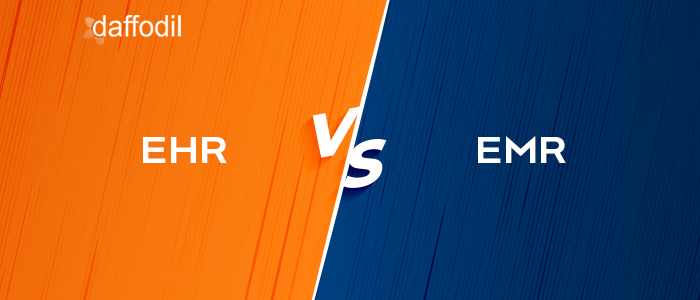
The healthcare industry has seen a drastic shift from paper to digital in the recent past. Several hospitals, clinics, healthcare practitioner’s offices, and facilities are increasingly switching to storing and maintaining patient medical records digitally.
Besides, electronic medical record-keeping is now mandatory for healthcare providers.
Electronic Health Record (EHR) and Electronic Medical Record (EMR) are used interchangeably in the medical fraternity. Having said that, there are always some differences to know and understand.
Both EHR and EMR are digital information of a patient’s health.
To break it down, EMR is a digital patient chart found at a specific clinic while EHR stores the entire history of a patient’s medical records. While EMR tracks a patient’s medical record including treatments from a physician and is maintained for the official purpose EHR provides a detailed glimpse at the patient’s treatments, diagnosis, test results, illnesses, and medication by multiple doctors at several locations.
With the use of both EMR and EHR, the healthcare system is only getting more effective while also cutting down on costs.
In this article, we will discuss how EHR is different from EMR and how the two are of crucial significance to any healthcare provider.
What is EHR?
Electronic Health Record or EHR travels with the patient, in other words, is shared among clinicians and healthcare providers. Even if a patient changes their physician or treatment – EHR ensures there is no lapse in the next treatment because of the easy accessibility to the previous medical records of the patient. Besides, with EHR the health care providers have access to multiple patient files, and this information provides comparative data and analysis which further leads to better patient treatment and care.
Among the most important reasons why clinicians must use EHR is the benefits and incentives they get from the government. Since it meets the compliance by the Centers for Medicare & Medicaid Services (CMS) healthcare providers have increased the use of EHR.
What is EMR?
While EHR is the comprehensive, holistic view of a patient’s medical past, an Electronic Medical Record or EMR is a digital record of a patient’s chart by a single physician, doctor, practitioner, dentist, clinic, surgeon, and more. It includes information such as diagnosis, number and types of treatments, medication. The best advantage of using an EMR is that it allows for better and efficient data tracking and saves time. It also provides timely reminders for future checkups and screenings.
Also Read: 5 ways Electronic Health Record (EHR) improves Patient experience
Key differences between EMR and EHR
Let’s look at some of the main differences between an Electronic Medical Record and an Electronic Health Record.
-While EMR is usually used by clinicians and doctors for noting down the treatment provided by them, EHR is the overall, detailed history of a patient’s medical record.
-EMR is a record filled in by a single healthcare provider whereas EHR includes medical records and treatments by multiple doctors from multiple clinics or hospitals.
-EMR is usually stored and maintained by a particular clinic or medical office and is usually not shared. EHR on the other hand is meant and designed to be shared across the healthcare providers for better assessment of a patient’s history.
-An EHR moves with the patient. Irrespective of the number of doctors a patient meets or the treatments they get – an EHR will record every medical step taken by a patient including pharmacy visits, lab tests, or hospital admissions.
Benefits of using the electronic records
As understood by now, both EHR and EMR are effective and beneficial to patients and clinicians in equal parts. Here are some of the advantages:
-Reduced risk of medical errors because of fast, constantly updated, and accurate data.
-Clear and concise patient charts without any hard-to-understand writing.
-Since the data is shared and accessible to other practitioners, the need for duplicate testing is reduced saving on costs and time.
-Higher accessibility to patient information means improved treatment and care with an accurate diagnosis.
-The electronic management of patient’s medical records also promotes better patient engagement and satisfaction.
-It also leads to increased preventive care encouraging patients to develop healthier lifestyles.
Also Read: Healthtech trends that are helping HCPs to tackle COVID-19
Conclusion
The healthcare industry benefits a lot from the use of electronic health records. Making a switch to one is not just the right thing to do but the demand of the system. But deciding on the right medical software is not easy. If you are looking for some advice on how to implement or which software to go for your medical business, then help is right here. If your organization is in the business of sharing information, then we recommend you invest in EHR technology. And if you are focused on providing treatment for a particular medical condition then an EMR may be a better business intelligence tool for you.
The primary thing to note here is to make an informed decision after running comparisons between a variety of solutions available in the market today. Before you settle for the one that is most suitable for your health facility we would suggest getting in touch with our experts.



